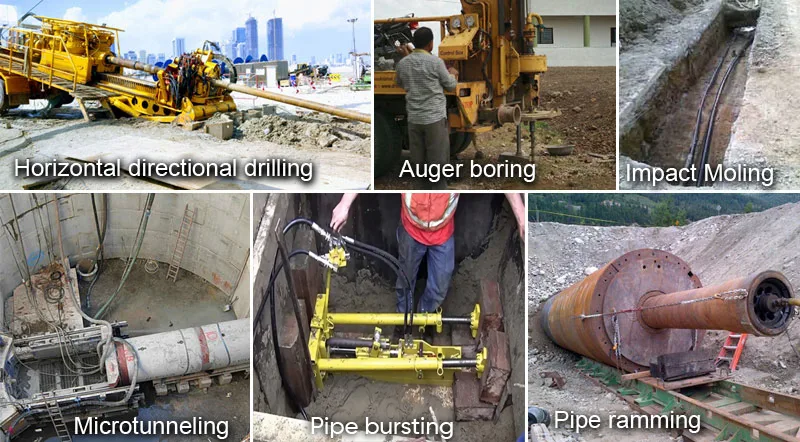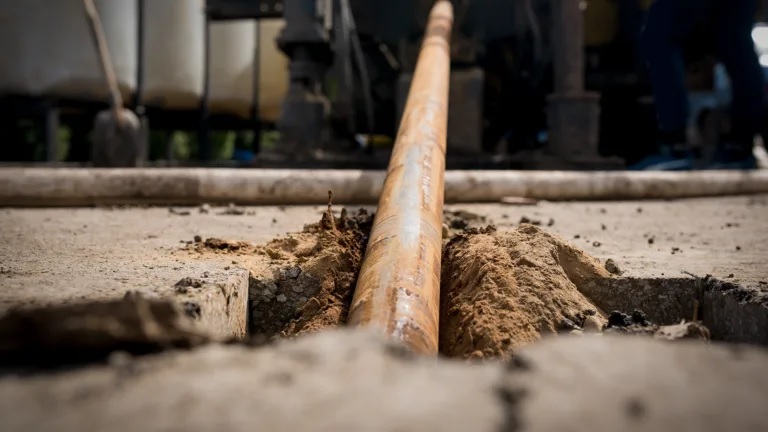Trenchless technology refers to a set of construction methods and techniques used for the installation, repair, and rehabilitation of underground infrastructure without the need for extensive open trench excavation. Instead of traditional open-cut excavation methods that involve digging trenches, trenchless technology utilises specialised equipment and methods to work underground with minimal surface disruption. It enables the installation or repair of pipelines, utility lines, cables, and other underground structures with minimal disruption to existing infrastructure, traffic, and surrounding areas. The primary goals of trenchless technology are to minimize disruption to the environment and public, reduce costs associated with construction projects, expedite project completion, preserve existing infrastructure, and provide sustainable solutions for the installation and maintenance of underground utilities.
Have you ever wondered in Metro project, how the sand comes out?
This is done with trenchless technology. There are several methods for removing sand or other materials from underground without the need for extensive excavation. One common method is through Horizontal Directional Drilling.

Given below are different types of trenchless methods
Trenchless Methods
Trenchless technology refers to a variety of methods used for the installation and repair of underground infrastructure without the need for traditional open trench excavation.
Trenchless Methods for New Installation
Horizontal Directional Drilling (HDD):
Horizontal Directional Drilling, also known as HDD or directional boring, is a trenchless method used for installing underground utilities such as pipelines, conduits, and cables. The process involves drilling a pilot hole from a launching point to a receiving point. A rotating drill bit is used to create the pilot hole, while guidance systems are employed to steer the drill underground. Once the pilot hole is completed, the drill string is replaced with the product pipe, which is then pulled back through the hole. HDD is suitable for various soil conditions and can accommodate installations at different depths and angles.
Pipe Bursting:
Pipe bursting is a trenchless technique used for replacing an existing underground pipe with a new one of the same or larger diameter. The process involves pulling a bursting head through the old pipe, which fractures it and pushes the fragments into the surrounding soil. Simultaneously, the new pipe is pulled into place behind the bursting head. Pipe bursting is commonly used for replacing deteriorated or undersized pipes and is applicable to various pipe materials such as concrete, clay, and PVC.
Pipe Jacking:
Pipe jacking is a trenchless method used for new pipeline installation or pipe replacement. It involves pushing a new pipe into the ground using hydraulic jacks, while simultaneously removing the excavated soil from a launch pit. The pipe is typically installed using a specially designed jacking frame that provides the necessary pushing force. Pipe jacking is suitable for various soil conditions and can be used for the installation of pipes in a range of diameters.
Microtunneling:
Microtunneling is a trenchless technology method used for precise and controlled pipeline installation. It is commonly employed in urban areas and under obstacles such as roads, railways, and rivers. Microtunneling involves using a microtunnel boring machine (MTBM) to excavate a tunnel while simultaneously installing the pipe behind it. The MTBM is operated remotely and can accurately control the tunnel alignment and grade. The excavated soil is transported out of the tunnel through a slurry system. Microtunneling is suitable for projects requiring high accuracy and minimal ground disturbance.
Moling;
Also known as horizontal soil displacement, is a method used for installing underground utilities, such as pipes or conduits, by creating a horizontal bore path through the soil without the need for open trench excavation. It involves a specialized moling machine that uses percussive or rotary action to displace the soil and create a tunnel for the installation of the utility.
Trenchless Methods for Repair
Slip Lining:
Slip lining is a trenchless technique used for rehabilitating existing pipes by inserting a new pipe into the host pipe. The new pipe, typically made of high-density polyethylene (HDPE), is smaller in diameter than the host pipe. The insertion can be accomplished by pulling or pushing the new pipe into position. Once in place, the annular space between the old and new pipe is usually grouted to provide stability. Slip lining is a cost-effective method for renewing deteriorated or undersized pipes and can be used for various pipe materials.
Cured-in-Place Pipe (CIPP):
Cured-in-Place Pipe, commonly referred to as CIPP, is a trenchless rehabilitation method used for repairing or renewing existing pipelines without excavation. It involves inserting a flexible liner into the damaged pipe. The liner is typically made of resin-saturated felt or fiberglass. Once in position, the liner is inflated and cured using heat or ultraviolet light, creating a new pipe within the existing one. CIPP is suitable for a wide range of pipe materials and sizes and can rehabilitate pipes with cracks, leaks, or corrosion.
Sliplining with HDPE:
Sliplining with HDPE (High-Density Polyethylene) is a trenchless technique used for rehabilitating deteriorated gravity sewer lines. It involves inserting a smaller diameter HDPE pipe into the existing pipe. The HDPE pipe is pushed or pulled into place, and the annular space between the old and new pipe is grouted for stability. Sliplining with HDPE can extend the service life of aging sewer lines and improve hydraulic capacity.
Pipe Coating:
Pipe coating is a method that involves applying an epoxy or polyurethane coating to the interior surface of an existing pipe. This process restores the structural integrity of the pipe, protects against corrosion, and improves hydraulic flow.
Pipe Ramming:
Pipe ramming is used to install new pipes by driving them into the ground using impact force. It is particularly suitable for hard soil conditions and can be used for the installation of various pipe materials, including steel, concrete, and plastic.

Equipments for Trenchless Methods;
Trenchless technology methods require specialised equipment to carry out the various installation and repair processes efficiently. Here are some of the key equipment used for different trenchless technology methods:
1. Equipments for New Installation:
a. Horizontal Directional Drilling (HDD):
- HDD Rig: This includes the drill rig, which consists of a drilling fluid system, drill pipe, drill head, and tracking equipment.
- Reamer: Used to enlarge the pilot hole to the desired diameter during the drilling process.
- Swivel: Connects the drill string to the reamer and allows rotation.
- Mud Mixing System: Used to create drilling fluid (mud) for lubrication and cooling during drilling.
b. Pipe Bursting:
- Bursting Head: A specialized tool that fractures the existing pipe while pulling the new pipe behind it.
- Hydraulic Power Unit: Provides the necessary force to pull the bursting head and new pipe through the old pipe.
- Pulling Equipment: Winches or hydraulic pullers used to apply pulling force to the bursting head and new pipe.
C. Pipe Jacking:
- Jacking Frame: Pipe jacking requires a jacking frame or jacking rig, which provides the necessary pushing force to advance the pipe into the ground. The jacking frame is equipped with hydraulic jacks or thrust cylinders.
- Thrust Wall or Reaction Wall: A thrust wall or reaction wall is constructed at the launch pit to provide a stable surface against which the jacking force is exerted.
- Cutting Tools: Cutting tools, such as a tunnel boring machine or excavation tools, are used to remove the excavated soil and create a void for the pipe installation.
D. Microtunneling:
- Microtunnel Boring Machine (MTBM): Microtunneling employs a microtunnel boring machine, also called a tunneling shield, which is specifically designed for accurate and controlled excavation. The MTBM typically consists of a cutterhead, jacking system, guidance system, and a slurry system for soil removal.
- Slurry System: Microtunneling uses a slurry system to transport the excavated soil out of the tunnel. The slurry, typically composed of bentonite or polymer, is pumped into the tunnel and then separated from the soil for recycling.
E. Auger Boring:
- Auger Boring Machine: A machine equipped with rotating cutting heads or augers to create a horizontal bore.
- Guidance System: Ensures accurate alignment and control of the auger boring machine.
- Jacking Frame: Provides support for the machine during the boring process.
F. Moling
- Moling Machine: A compact, self-contained machine specifically designed for soil displacement.
- Guidance System: A tracking or guidance system is used to control the direction and alignment of the moling machine during the bore
- Pipe Pushing Equipment: Once the bore is created, specialized equipment that includes pushing rods, jacks, or winches to advance the pipe through the created tunnel.
- Pipe or Conduit: The specific pipe or conduit material depends on the project requirements. Common materials include PVC, HDPE, steel, or fiberglass.

2. Equipments for Repair:
a. Cured-in-Place Pipe (CIPP) Lining:
- Inversion Equipment: Inversion drums or bladders used to invert and position the liner within the existing pipe.
- Curing Equipment: Steam generators, hot water units, or UV light systems used to cure the liner in place.
b. Slip Lining:
- Pipe Bursting Equipment: Similar to the equipment used for pipe bursting, including bursting heads and pulling equipment, but with smaller-diameter pipes.
c. Pipe Coating:
- Coating Applicator: Equipment for applying epoxy or polyurethane coatings to the interior of the existing pipe. This can include spray systems, rollers, or brushes.
d. Pipe Ramming:
- Ramming Hammer: Heavy-duty pneumatic or hydraulic hammers used to drive the pipe into the ground.
- Casing Pipe: The pipe to be rammed into the ground.
Trenchless technology demand in India
Trenchless technology has gained significant importance and witnessed growing demand in India due to several factors:
1. Urbanization and Infrastructure Development: Trenchless technology offers a viable solution to construct and rehabilitate underground infrastructure with minimal disruption to urban areas.
2. Limited Space and Congested Urban Areas: Trenchless technology allows for the installation, repair, and replacement of underground utilities with reduced surface disruption, minimizing the impact on traffic flow, buildings, and other structures.
3. Faster Project Completion: Trenchless methods often offer faster project completion times compared to traditional methods. This factor is particularly valuable in urban areas, where minimizing disruption and reducing project timelines are essential.
4. Preserving Existing Infrastructure: India has a rich historical and cultural heritage, and trenchless technology allows for the installation or repair of underground infrastructure without damaging or displacing existing structures, such as heritage buildings, monuments, or archaeological sites. This aspect of trenchless technology is vital for preserving India’s cultural heritage.
Conclusion
The demand for trenchless technology in India is getting increased steadily. The government, municipalities, and utility companies are recognizing the benefits of trenchless methods and actively adopting them in various infrastructure projects. With the continuous urbanisation and focus on infrastructure development in the country, trenchless technology is expected to play a crucial role in meeting India’s growing demands while minimising disruption and environmental impact.


